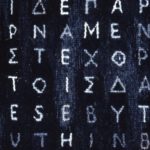This post was published contiguously on the Logos Academic Blog.
Introduction
Two weeks ago, Tavis Bohlinger wrote a blogpost in which he encouraged students and scholars of the New Testament to focus on the “common dialect,” ἡ κοινὴ διάλεκτος of the Greek language—that is, the Greek spoken roughly between 300 BCE and 300 CE. In the German-speaking sphere, from which I come, many students of theology still learn “Classical Greek” as it was used between 500 and 300 BCE (well, at least the Attic dialect of that time).
I really appreciate Tavis’ emphasis, because it is my impression that many students have a hard time transitioning from Plato to Paul—and far too often you can even find comments in German scholarly publications that have a solid basis in the grammar of Kühner and Gerth—but not in actual language usage in the first century CE.
Tavis also suggested a strategy for mastering Koine, which among other things included “reading through” Greek grammars. In response, Vinh T. Nguyen argued that every grammar has its time and place. Accordingly, he suggested that it might actually be more confusing than helpful to read different treatments on the same topic from grammars that stem from different backgrounds. I think this is a valid concern—though I have to confess that I find Vinh’s periodization and implicit ranking of grammars rather astonishing. The assumption that the Greek verb does not encode temporality grammatically serves as a kind of litmus test for a grammar that is said to belong to the “modern-linguistic” period—even though this position is advocated mostly by NT scholars (Porter, Campbell) and is not shared by most linguists (e.g., Adrados, Duhoux). Does this agreement with the linguistic consensus disqualify a grammar such as the one by Heinrich von Siebenthal from being “modern-linguistic”? (On this issue, cf. also the blog post by Wayne Coppins, who translates a passage from Heinrich von Siebenthal’s grammar; for the Logos-version see here.)
Besides this quibble, I am also not so sure whether Vinh actually succeeds in pointing to a constructive alternative after having “dethroned” grammar. The “important monographs on Greek” also have a specific research context in which they emerged. And even though NT scholarship has profited greatly from the research done primarily in an evangelical, North American context, I am also often surprised to see how unquestioned certain assumptions from this research tradition find their way into the exegetical literature.
Also, Vinh quotes a great formula (“Knowledge + Practice = Skill”), but I am still not sure what a student of the NT is actually expected to practice (presupposing monographs and contextualized grammars provide the knowledge). In any case, the exchange between Tavis and Vinh has made me think about my own engagement with the Greek language and whether I could point to some specific strategies and tactics that turned out to be helpful for myself and that might, perhaps, also be valuable to others.
So, how did I master Koine Greek?
Memorizing and Parsing
During my BA studies, I learned Koine under Heinrich von Siebenthal. In the second semester, he introduced his linguistic analysis of texts, but in the first semester our class followed the typical approach of learning vocabulary and tables with inflexion endings. I was never a huge fan of such a procedure because in the actual reading of Greek texts you usually do not want to recite the third declension simply to identify the function of a word on the page.
However, when I recently taught a Greek reading module at another institution and I noticed that the students were barely able to identify any verb form, I came to the conclusion that I might have been too critical towards this traditional approach. At least we were in the position to identify virtually every word form in the NT after two semesters, and it’s probably the fault of the wider curriculum (which didn’t include sufficient opportunities to practice our knowledge), and of my own laziness, that I haven’t profited sufficiently in the long term from all the memorizing.
Translating
Interestingly, with regard to learning syntax, we followed a slightly less traditional path. We used a textbook that Heinrich von Siebenthal had written based on a method by Otto Wittstock. It makes use of insights from simultaneous translating of modern languages and aims at teaching students to learn to read Greek texts in way that is similar to the procedure of professional interpreters. This approach requires memorizing a lot of rules that have mainly to do with the differences between Greek and German syntax. Thus, there is a heavy emphasis on the target language, which is not too helpful in achieving “understanding” (as Vinh calls it). On the other hand, the approach ensures that you actually learn the relevant Greek syntax (i.e., those aspects that might actually cause some problems in understanding because of your mother tongue, which, whether we like it or not, will always influence our perception of the foreign language we are dealing with.
Living Koine
Due to my dissatisfaction with my Greek language skills, I continued to keep my eyes open for other approaches that might get me to a point that I deemed desirable. I had been using the “reconstructed” pronunciation by Randall Buth for some years already, when I met Jordash Kiffiak in Zurich. Jordash had been involved in the development of the approach and the teaching material and had been teaching Koine as a spoken, living language for quite some time in different contexts. My wife and I encouraged him to do a class for the theology students in Zurich as well, and had the chance to participate ourselves and see how this pedagogical approach might work in an academic setting. (He had already presented his method a few months earlier, and I have written about this workshop here).
On the one hand, this experience confirmed my suspicion that there are many advantages in learning word forms and basic collocations through hearing, speaking, and acting. Such a procedure allows for a more natural segmentation of grammatical information versus learning whole declension paradigms without any pragmatic context. I still think there is a lot of potential for teaching Koine this way.
On the other hand, the desire to remain as much as possible “in” the Greek language seems to also put a substantial limit on how fast you can progress with students and what kind of level you can achieve within the time that you usually have for teaching Greek at universities or seminaries. To be fair, there is some teaching material that aims at achieving some kind of fluency, but in practice the results one can expect is probably closer to what one might learn of a modern language during a one-semester stay in another country—or, rather, what one might learn during such a stay if you only talked to a single person. The diversity of Koine Greek appears in quite unified form in the living-language approach. For example, after Jordash’s class we tried Christophe Rico’s “Speaking Ancient Greek as a Living Language.” In the very first session, students are supposed to internalize ἆρα as a question particle—which doesn’t prepare you at all for dealing, for example, with questions and interrogative particles in the New Testament.
Despite my initial enthusiasm, I have actually become quite skeptical of whether teaching Koine as a living language will help students to “master” Greek. In other words, I am quite sure that the “communicative” teaching material I have seen so far will not get students to a point where they would know the language well enough to offer a satisfying descriptive account of their understanding of the text. To be sure, all else equal, students who have had a semester of Koine as a living language will most certainly be able to extract more information from a Greek passage and to do it faster than students who learned through the traditional approach. This is not, however, what we are usually after in exegesis and, in my opinion, the result is also not close enough to fluency to constitute a valid alternative to this goal.
Modern Greek
All this emphasis on “speaking” leads me to another aspect of my journey with Greek: I have been visiting Greece almost every year since I was a little child. Thus, learning Modern Greek had always been on my agenda to a certain extent. I actually intentionally tried to keep it separate from my study of Ancient Greek to avoid mixing up forms and meanings. The use of the reconstructed pronunciation seemed to help this segregation.
But then, when I also had to speak Koine in Jordash’s class, this barrier collapsed and I began to blend both phases of the Greek language in an ugly manner, to the point that I could hardly conduct an intelligible conversation in Modern Greek. Ultimately, dropping the reconstructed pronunciation actually helped me tremendously. I still make many anachronistic mistakes (that cause my students to doubt my abilities and the Greek waiter to do the same with my sanity). Still, allowing my mind to accept and explore the continuity between Ancient and Modern Greek, I have the impression that my reading of Koine texts has profited substantially.
Most NT scholars probably have some experience with Modern Greek and I definitely encourage students to follow this example. Besides my personal interest in the culture and language of the Greek nation, I think it’s a matter of respect to have some basic knowledge of how Greek is used today—not so much because it would allow us to take into account Greek scholarship by Greeks (although that would be commendable), but simply because we can easily lose sight of the fact that we are dealing with Greek literature on a daily basis. In other words, we are constantly commenting on cultural artefacts that are part of a tradition that still has 13 million native speakers today.
I wouldn’t go so far as to call it a matter of “basic human decency” since such claims have recently revealed a certain potential to backfire, but I do have the impression that it wouldn’t hurt NT scholarship if we made ourselves more aware of the fact that in a certain sense we (speaking of non-Greek biblical scholars) are actually dilettantes in the area of our professed expertise. And the kind of humility that comes from the humiliation of trying to communicate in Modern Greek with people who actually speak that language might help prevent us from some of our stupidest assertions of what is or is not “possible in Greek.”
This line of reasoning is also, by the way, my main argument for favoring the use of the modern pronunciation of Greek in NT scholarship. (Since there is no “historical” pronunciation to be reconstructed anyway, it seems perfectly fine to follow political reasoning. But this is probably a topic for another post … )
So, did I finally master Koine Greek once I had realized how much my (quite limited) knowledge of Modern Greek might actually contribute to my interaction with Ancient Greek texts? Unfortunately, no. On the one hand, learning Modern Greek is a continuous struggle on its own for me. In addition, my hopes that mastery of that stage of the language would automatically make me an expert in Koine Greek received a severe setback: I showed Koine texts to Greek native speakers (who were not at the same time also Biblical or Classical scholars) and they were not able to make much sense of what they were presented with. This might be different for people who grew up with the Katharevousa used in the 1960s in Athens, but for young Greeks, the distance between their language and the Koine seems to be much bigger than Caragounis in his enthusiastic “Streitschriften” seems to be willing to admit.[1]
Text Grammar
How, then, did I finally master Koine Greek? The short answer is that I haven’t. However, there is one further aspect that I found helpful and that combines both Tavis’ insistence on “working through” a Greek grammar to achieve grammatical knowledge and Vinh’s plea for “practice.”
When I researched narratives and narrative sub-structures in the letters of Paul, I had to deal with the question of how Paul creates “temporal order” (which is regarded as constitutive or at least essential for narrativity by all narratologists). To this end, I applied Heinrich von Siebenthal’s text grammar to the Pauline corpus.
Note that in the English-speaking sphere in discussions of discourse analysis, “text grammar” is often associated with an outdated, transphrastic understanding of the category of “text.”[2] By contrast, Heinrich von Siebenthal follows the “integrative” text model of the text linguists Christina Gansel and Frank Jürgens, who integrate pragmatic considerations in their definition of textuality and, thus, define “Textgrammatik” as “pragmatic grammar.”[3] It is my fundamental conviction that, just as we make use of insights into Greek syntax for the analysis of Greek sentences in the NT, we should also take into account the current state of text-grammatical research when dealing with the structure of whole texts.
For the present purpose, I do not want to explicate this more general argument but rather focus on how I personally benefited from working with the relevant paragraphs in Heinrich von Siebenthal’s grammar (§297–354 in Griechische Grammatik zum Neuen Testament = GGNT). In explicating how coherence is achieved in texts, von Siebenthal builds on categories also used in the “Duden,” the standard German grammar,[4] to classify sense-relations between propositions. However, these basic options for how propositions are connected semantically are not dependent on a specific language (cf. GGNT 352a). So my systematic analysis of temporal “connexions” (pairs of propositions) in the letters of Paul was refreshingly different from other lines of reasoning and learning I had followed earlier.
For example, I began with a category like “simultaneity,” discovered the many differentiations that can be made within this broader concept, and then inquired where and how Paul had realized it in his letters (and how he differed from other authors of his time). For me, this was very different from my usual way of “practicing” Greek, (i.e., translating or reading/speaking/understanding). At the same time, it differed from my past attempts to build my “knowledge” (by going through sections on specific questions of Greek syntax in grammars). And in both ways this new approach seemed to be more fruitful.
With regard to “knowledge,” I realized I was suddenly able to memorize aspects of Greek syntax that I had often read before but was not able to keep in my head. For example, when I approached the subcategory of “repetitive simultaneity” (cf. GGNT 330a), for the first time I had a place to store information about the iterative optative in Classical Greek and the corresponding use of Aorist and Imperfect Indicative in subordinate clauses in the Koine (the so-called “hellenistische Nebensatziterativ” (GGNT 211i; cf. BDF 367). At the same time, I learned something about German as well—for example, that the use of the conjunction “wenn” with preterite always has in view the same constellation (see Duden 1769).
So in the end, choosing text grammar as your point of departure will in fact cause you to (re-)consult treatments of Greek syntax (i.e., to go from temporal connexions to temporal clauses and adverbial participles, from conditional connexions to conditional clauses, etc.) Also, this approach will constantly drive you to dictionaries and searchable text corpuses, to be sure, not the least because the list Heinrich von Siebenthal offers (even if supplemented by comparable English literature) is not complete (cf. in particular GGNT 325b).
At the same time, I think from the perspective of “practice” this was also a beneficial exercise. I had—as Tavis encourages to do—annotated specific Greek writings before, going through passage indexes in Greek grammars and reading through sections that I thought might be relevant for problems in the text.[5] When I read the same passage again now, I often remember what I had looked up and it’s easier for me to understand the text in question. But I could probably not say with certainty whether a similarly looking phenomenon in another text belongs to the same category or whether it should actually be treated differently. By contrast, whenever I now encounter an ὅτε in a Greek text, I remember the different ways this word can be used in temporal contexts and I have a broader context that allows me to evaluate the verse in question.
To be sure, approaches to teaching Greek as a living language also prioritize practicing the expression of specific ideas (over against translating German or English phrases). However, at least in my perception, there is a lack of emphasis on the variegated options for expressing the same idea and the slight pragmatic differences between them. By contrast, if you begin with von Siebenthal’s text-grammatical categories, you will soon see, on the one hand, how individual authors associate specific connectors and alternative constructions for making subtle semantic distinctions and, on the other hand, where stylistic preferences and contextual factors influence the expression level of the text.
For example, Matthew prefers the adverb τότε to introduce a new event in a sequence in a series of main clauses. While Matthew displays a stylistic preference for this adverb also in comparison to the other gospels, it is striking that Paul almost never uses this mode of narration in general (i.e., ἔπειτα and εἶτα also appear only sporadically). In his case, the pragmatic dimension of the communication often seems to “relieve” the Greek syntax:[6] Paul can often use prepositional phrases with infinitives or action nouns because in the communicative context of his letter he can presuppose that the readership already knows the “story.” The function of the text is not to inform about events heretofore unknown, but to stipulate a reevaluation of these events or even to encourage action.[7]
Conclusions
I haven’t mastered Koine, and I don’t think there is any chance that I will do so in the near future. My constant dissatisfaction with my own skills relating to the Greek language have led me, however, to reflect more than once on how such mastery might be achieved or at least approached in the best manner. Many scholars have succeeded in developing an impressive proficiency in Koine Greek. Yet, the dominating impression for me is that learning Greek remains a frustrating experience even for many of the most diligent students.
The communicative approach certainly has some potential for offering a remedy for this unfortunate situation. However, in my opinion, the integration of this pedagogical paradigm with a teaching process that enables students to also offer a linguistically valid, descriptive account of their interpretation of texts so far remains unaccomplished. Most importantly, I expect that for such a didactic reboot to take place, fundamental changes would have to be made to the curriculum at universities and seminaries in general. 300 hours of study is not enough time to teach Greek in a way that students will fully internalize word forms, collocations, and meanings, while also offering them tools for analyzing the syntax and larger text structure. I would greatly appreciate hearing from people who have experienced efficient methods and contexts that helped them to achieve a satisfying mastery of Koine Greek in less than a few decades (with the recognition that “mastery” is itself a relative term). I say this recalling that Erasmus boasted to a friend that he had mastered Koine is just two years, at that at the age of 34.
In the meantime, I hope this blogpost—and the recommendation to focus on Modern Greek and to use text-grammatical categories as point of departure—might turn out to be helpful to some who find themselves in a situation similar to mine: students and scholars of the New Testament who are frustrated that they had not better learnt Greek in the first place and who do not have the time and opportunity to begin all over again (or who are tired of attempting to relearn once again), but who would like to have some tools at hand to at least improve certain areas of their linguistic capabilities relating to Koine Greek.
[1]Cf., for example, Chrys Caragounis, The Development of Greek and the New Testament: Morphology, Syntax, Phology, and Textual Transmission, WUNT 167 (Tübingen: Mohr Siebeck), 56, grumbling about the “solution” of the Language Question and pointing to “non-Greek vocables, which, often, are”—so he claims—“not understood by ordinary Greeks.”
[2]See, e.g., Stanley E. Porter’s “Discourse Analysis and New Testament Studies: An Introductory Survey,” in Discourse Analysis and Other Topics in Biblical Greek, ed. Stanley E. Porter and D. A. Carson, JSNTSSup 113 (Sheffield: Sheffield Academic, 1995), 20.
[3]Christina Gansel and Frank Jürgens, Textlinguistik und Textgrammatik, 3rd ed., UTB 3265 (Göttingen: Vandenhoeck & Ruprecht, 2009), 113.
[4]Duden: Die Grammatik, 9th ed. (Berlin: Dudenverlag, 2016), §1758ff.
[5]By the way: BDR and BDF have a great Scripture index. If you are working with GGNT, I suggest you also buy the Neue Sprachliche Schlüssel from Haubeck and von Siebenthal (for the Logos-version see here), which is not only great for beginners but also helpful as a key to von Siebenthal’s grammar.
[6]Cf. Gansel and Jürgens, Textlinguistik, 174, saying „dass Pragmatisches die Anforderungen an die Syntax entlastet.”
[7]For a first orientation concerning the linguistic concept of text function, see GGNT 302.
Christoph Heilig is the author of Hidden Criticism? (Fortress, 2017) and Paul’s Triumph (Peeters, 2017). Additionally, he has co-edited (with J. Thomas Hewitt and Michael F. Bird) God and the Faithfulness of Paul: A Critical Examination of the Pauline Theology of N. T. Wright (Fortress, 2017). In his most recent project, he discusses the importance of “stories” and “narrative substructures” for understanding Paul’s letters.







Keine Kommentare vorhanden
Es gibt noch keine Kommentare.
Kommentar schreiben